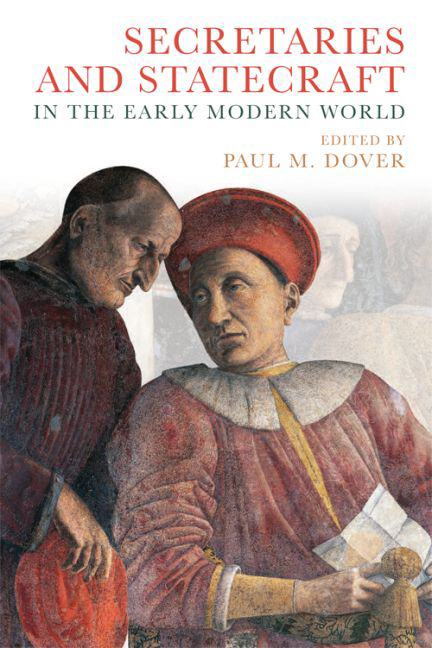Book contents
- Frontmatter
- Contents
- List of Contributors
- 1 Introduction: The Age of Secretaries
- 2 Records, Politics and Diplomacy: Secretaries and Chanceries in Renaissance Italy (1350–c. 1520)
- 3 Mercurino di Gattinara (1465–1530): Imperial Chancellor, Strategist of Empire
- 4 ‘This continuous writing’: The Paper Chancellery of Bernhard Cles
- 5 Parables and Dark Sentences: The Correspondence of Sir William Cecil and William Maitland (1559–73)
- 6 Axel Oxenstierna and Swedish Diplomacy in the Seventeenth Century
- 7 Statecraft and the Role of the Diplomat in Ducal Savoy: The Career of Alessandro Scaglia (1592–1641)
- 8 Richelieu, Mazarin and Italy (1635–59): Statesmanship in Context
- 9 The Learned Ideal of the Mughal Wazīr: The Life and Intellectual World of Prime Minister Afzal Khan Shirazi (d. 1639)
- 10 Reconsidering State and Constituency in Seventeenth-Century Safavid Iran: The Wax and Wane of the Munshi
- 11 Choreographers of Power: Grigorii Kotoshikhin, State Secretaries and the Muscovite Royal Wedding Ritual
- 12 Eberhard von Danckelman and Brandenburg's Foreign Policy (1688–97)
- 13 Chancellor of State: Prince Wenzel Anton Kaunitz, the Habsburg Foreign Office and Foreign Policy in the Era of Enlightened Absolutism
- Index
10 - Reconsidering State and Constituency in Seventeenth-Century Safavid Iran: The Wax and Wane of the Munshi
Published online by Cambridge University Press: 21 November 2017
- Frontmatter
- Contents
- List of Contributors
- 1 Introduction: The Age of Secretaries
- 2 Records, Politics and Diplomacy: Secretaries and Chanceries in Renaissance Italy (1350–c. 1520)
- 3 Mercurino di Gattinara (1465–1530): Imperial Chancellor, Strategist of Empire
- 4 ‘This continuous writing’: The Paper Chancellery of Bernhard Cles
- 5 Parables and Dark Sentences: The Correspondence of Sir William Cecil and William Maitland (1559–73)
- 6 Axel Oxenstierna and Swedish Diplomacy in the Seventeenth Century
- 7 Statecraft and the Role of the Diplomat in Ducal Savoy: The Career of Alessandro Scaglia (1592–1641)
- 8 Richelieu, Mazarin and Italy (1635–59): Statesmanship in Context
- 9 The Learned Ideal of the Mughal Wazīr: The Life and Intellectual World of Prime Minister Afzal Khan Shirazi (d. 1639)
- 10 Reconsidering State and Constituency in Seventeenth-Century Safavid Iran: The Wax and Wane of the Munshi
- 11 Choreographers of Power: Grigorii Kotoshikhin, State Secretaries and the Muscovite Royal Wedding Ritual
- 12 Eberhard von Danckelman and Brandenburg's Foreign Policy (1688–97)
- 13 Chancellor of State: Prince Wenzel Anton Kaunitz, the Habsburg Foreign Office and Foreign Policy in the Era of Enlightened Absolutism
- Index
Summary
As noted by Rudi Matthee in his 2010 article ‘Was Safavid Iran an Empire?’, there is a conspicuous absence of comparative studies of early modern empires and political systems across Europe and Asia that engage the Safavid dynasty of Iran (r. 1501–1722). However, what is particularly lacking within the field of Safavid studies is a conversation which addresses the thematic concerns that are currently shaping the study of the Mamluk, Ottoman and Mughal states. Marshall Hodgson, in his seminal study The Venture of Islam, argued that the model of military patronage state best represented the political reality of the post-Mongol Islamic world. Indeed, this notion of military patronage state (MPS) served as the underpinning for the historiographical leviathan of the ‘gunpowder empire’ paradigm. Keen to nuance Hodgson's ideas for a Mamluk setting, Van Steenbergen argues that the model of the MPS does not accept the notion of a unitary state which exists independently of its surrounding constituencies, elite or otherwise. Rather, politics is not conducted on the basis of static institutions, but rather through constituency membership and the act of patronage. Farhat Hasan argued similarly against overly structuralist approaches when examining the political landscape of Mughal India, and he explicitly rejected Stephen Blake's Weberian ‘patrimonial-bureaucratic’ model in favour of a methodology which understood state power in a much more reflexive and fluid manner. In recent years, there have been lively debates regarding how we can look to seemingly quotidian institutions – chanceries, judiciaries, bureaucracies – to understand better the exercise and articulation of power in pre-modern settings. This chapter contributes to these debates by examining the secretarial culture of the seventeenth-century Safavid Empire, in particular the changing roles and fortunes of the ‘state-secretary’ (munshi al-mamalik).
Admittedly, Safavid historians face a number of issues which prevent the ready acceptance of such military or household-specific models, which seem to thrive in Mamluk historiography and other contexts. First and foremost, the Safavid ‘royal’ dynasts came into existence as the spiritual leaders of a militarised millenarian Sufi Order.
- Type
- Chapter
- Information
- Secretaries and Statecraft in the Early Modern World , pp. 206 - 234Publisher: Edinburgh University PressPrint publication year: 2016

